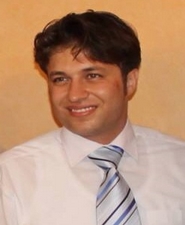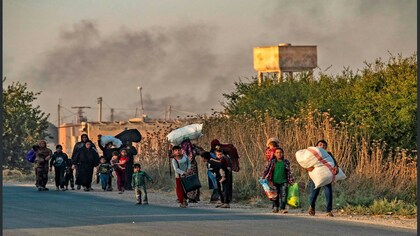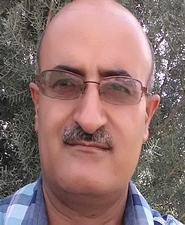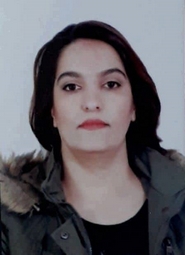Anatomy of a Political Assassination by Iranian Criminal leaders
13:35 - 6 May 2014

Akam Assadi
Iran has been ruled by Islamic Republic political system, since following the collapse of Shah in 1979. The Iranian government is based on the concept of Vali-ye faqih, which is a system of governance in which a faqih is to serve as the Supreme Leader. However, following calls that this idea was undemocratic, the system was moderately altered into the current \"Islamic Republic\", in which a council of clerics, who are elected by the people, choose the Supreme Leader who, per the constitution, has to be a cleric. These means that Iran is a Islamic government but when we see the reality, we will arrive at these facts that Iran is a terrorist regime and carry out terrorist activities behind the veil of Islam. It was a short introduction to explain one of the most brutal acts of the regime against the Kurdish nation and their leaders.
In September 1992 agents of the Islamic Republic of Iran (IRI) murdered three leading members of Democratic Party of Iranian Kurdistan (KDPI) in the Mykonos Restaurant in Berlin. The attack was one of the series of assassinations designed to intimidate and disrupt the activities of political opponents of the Islamic Republic.
The success of the Islamic Revolution, the Government of the Islamic Republic of Iran (IRI) has demonstrated an unwavering commitment to exporting its revolution abroad. Since December 1979 Iranian intelligence agents have assassinated monarchist, nationalist and democratic activists in countries as diverse as the United States, Austria, Dubai, France and Turkey.
Iran is increasingly being held accountable for its terrorist activities outside its borders. In November 2006 an Argentin federal judge issued an arrest warrant for eight IRI officials including Former Iranian President Akbar Hashemi Rafsanjani and Ali Akbar Velayati former Foreign Minister in which implicated in the bombing of a Jewish cultural center in Buenos Aires in July 1994 which killed 85 people. Arrest warrants for Iranian officials have also been issued by Switzerland in April 2006 for the murder of Professor Kazem Rajavi and by Austria in 1989 for the murder of Kurdish leader Dr. Abdul-Rahman Ghassemlou. Iran’s former Intelligence Minister, Ali Fallahian, who is featured on the cover of this report, is currently the subject of no less than three separate international arrest warrants.
In this context, the Mykonos case has particular significance because it opens a window on a secret world. The trial of many, but sadly not all, of those involved elicited minute operational details about Iran’s program of political assassinations and about the kind of men recruited to carry it out. The testimony of a high-ranking former Iranian intelligence officer with direct experience of such operations provided a rare insight into the political direction behind such attacks. The unprecedented release of German intelligence materials laid bare for public examination the infrastructure that supported Iranian Intelligence operations in Western Europe.
The Mykonos operation was authorized by the Islamic Republic’s powerful Special Affairs Committee, which at the time of the murders was headed by Supreme Leader Ali Khamenei and included President Akbar Hashemi Rafsanjani, Minister of Intelligence Ali Fallahian and Foreign Minister Ali Akbar Velayati. The Committee charged Fallahian with superintending the operation.
The Mykonos operation was carried out by personnel from the Special Operations Council of the IRI Ministry of Intelligence and by freelance operators recruited by agents of the IRI Ministry of Intelligence in the field. Fallahian put Abdul-Rahman Banihashemi in charge of the Mykonos team. Banihashemi was assisted in Germany by a locally-based agent of the IRI Ministry of Intelligence called Kazem Darabi.
Darabi recruited four Lebanese nationals resident in Germany - Youssef Mohamad El-Sayed Amin, Abbas Hossein Rhayel, Mohammad Atris, and Ataollah Ayad – known to him through their associations with either Hezbollah or Amal - to assist in the operation.
The primary targets of the Mykonos operation were Dr. Mohammad Sadegh Sharafkandi, the Secretary-General of the KDPI, Fatah Abdoli, the KDPI \'s European representative, and Homayoun Ardalan, the KDPI’s representative in Germany. Nourrollah Dehkordi, a friend of Dr.
Sharafkandi, was also killed in the attack, and Aziz Ghaffari, the owner of the Mykonos restaurant, was wounded. The actual killings were committed by Abdul-Rahman Banihashemi and Abbas Hossein Rhayel, an experienced Hezbollah operator, who administered the final shots to both Ardalan and Sharafkandi.
Youssef Amin provided security for the assassins blocking the entrance to the restaurant for the duration of the attack. Farajollah Haidar drove the getaway car and an Iranian national known only as Mohammad kept the targets under surveillance prior to the attack. Although Banihashemi, Haidar and Mohammad were successfully able to escape from Germany, most of the other immediate Mykonos conspirators were soon arrested.
German prosecutors indicted Rhayel, Darabi and Amin each on four counts of murder and one count of attempted murder. Two other associates were indicted for aiding and abetting the attacks. The Mykonos trial lasted three and a half years.
The court met for a total of 246 sessions, heard 176 witnesses, accepted testimony from a former senior intelligence officer of the IRI Ministry of Intelligence, and considered documentary evidence varying from secret intelligence files to tapes of Iranian television broadcasts. Prosecutors successfully obtained convictions in four of the five cases. Rhayel and Darabi both received life sentences for their role in the attack.
The German authorities concluded that the Iranian government was “directly involved” in the Mykonos assassinations and in March 1996, Chief Federal Prosecutor Kay Nehm took the unprecedented step of issuing an international arrest warrant for the Iranian Minister of Intelligence, Ali Fallahian.
The warrant stated that Fallahian was strongly suspected of the murders. Further warrants were issued for two Tehran-based agents of the IRI Ministry of Intelligence who had played an early role in planning the Mykonos operation. Outstanding arrest warrants also still exist for Abdul-Rahman Banihashemi and Haidar. Both men are currently believed to be residing safely in Iran.
Kurdistan Democratic Party of Iran (KDPI) is the leading Kurdish political party in Iran and one of the most significant political groups opposing the Islamic Republic. KDPI Founded on August 16, 1945 in Mahabad, Iran,the Party’s declared objective is to win Kurdish autonomy in administrative, legal and educational matters without jeopardizing Iran’s territorial integrity.
The origins of the Mykonos attack can be traced to the decision by the IRI’s Special Affairs Committee (Komitey-e Omour-e Vizheh) to appoint Ali Fallahian, then Iran’s Minister of Intelligence, to oversee the elimination of KDPI leadership.
Former Iranian President Abdolhassan Banisadr testified that the Mykonos murders had been personally ordered by Ali Khamenei, Iran’s Supreme Leader, and President Akbar Hashemi Rafsanjani. Banisadr former Iranian president stated that he had confirmed this information with well-placed sources with direct knowledge of the inner workings of the IRI Ministry of Intelligence.
The Islamic Republic of Iran has long been committed to eradicating centers of political opposition to the regime both at home and abroad.
Between 1979 and 1996, the leadership of the Islamic Republic ordered a series of high profile political assassinations, many of which occurred in Western Europe. After Khomeini’s death in 1989, the responsibility for directing this campaign was assumed by the Special Affairs Committee headed by Khomeini’s successor as Supreme Leader, Ali Khamenei.
Operational responsibility for carrying out the Special Affairs Committee’s instructions fell to the Special Operations Council of the Ministry of Intelligence.
The Mykonos case provides the best insight to date into Iran’s campaign of overseas assassinations. The operation vividly illustrates Iran’s use of terrorist proxies to pursue its targets where its own local resources are lacking. The plan was both cheap and effective. The modus operandi used by the Mykonos team limited the exposure of the Ministry of Intelligence assets but made little attempt to disguise the origins of the operation or mislead investigators.
No attempt was made to remove the serial numbers from the weapons used in the attack nor was any serious attempt made to dispose of them so that they could not be traced back to Iran. This suggests that the IRI may have seen some advantage in confirming to the opposition community that it was behind the attacks.
Perhaps the most significant aspect of the Mykonos episode is the unwavering hostility the IRI demonstrated towards KDPI. Dr. Sharafkandi was the second leader of the KDPI to be murdered in a European city in three years. In all, Iran Human Rights Documentation Center (IHRDC) is aware of dozens of rank and file members of the KDPI killed by the Iranian regime outside its borders, mostly in Iraq. The calm professionalism of the Mykonos killers is emblematic of the ruthlessness with which the Islamic Republic has consistently sought to counter its political opponents.
Iran has been ruled by Islamic Republic political system, since following the collapse of Shah in 1979. The Iranian government is based on the concept of Vali-ye faqih, which is a system of governance in which a faqih is to serve as the Supreme Leader. However, following calls that this idea was undemocratic, the system was moderately altered into the current \"Islamic Republic\", in which a council of clerics, who are elected by the people, choose the Supreme Leader who, per the constitution, has to be a cleric. These means that Iran is a Islamic government but when we see the reality, we will arrive at these facts that Iran is a terrorist regime and carry out terrorist activities behind the veil of Islam. It was a short introduction to explain one of the most brutal acts of the regime against the Kurdish nation and their leaders.
In September 1992 agents of the Islamic Republic of Iran (IRI) murdered three leading members of Democratic Party of Iranian Kurdistan (KDPI) in the Mykonos Restaurant in Berlin. The attack was one of the series of assassinations designed to intimidate and disrupt the activities of political opponents of the Islamic Republic.
The success of the Islamic Revolution, the Government of the Islamic Republic of Iran (IRI) has demonstrated an unwavering commitment to exporting its revolution abroad. Since December 1979 Iranian intelligence agents have assassinated monarchist, nationalist and democratic activists in countries as diverse as the United States, Austria, Dubai, France and Turkey.
Iran is increasingly being held accountable for its terrorist activities outside its borders. In November 2006 an Argentin federal judge issued an arrest warrant for eight IRI officials including Former Iranian President Akbar Hashemi Rafsanjani and Ali Akbar Velayati former Foreign Minister in which implicated in the bombing of a Jewish cultural center in Buenos Aires in July 1994 which killed 85 people. Arrest warrants for Iranian officials have also been issued by Switzerland in April 2006 for the murder of Professor Kazem Rajavi and by Austria in 1989 for the murder of Kurdish leader Dr. Abdul-Rahman Ghassemlou. Iran’s former Intelligence Minister, Ali Fallahian, who is featured on the cover of this report, is currently the subject of no less than three separate international arrest warrants.
In this context, the Mykonos case has particular significance because it opens a window on a secret world. The trial of many, but sadly not all, of those involved elicited minute operational details about Iran’s program of political assassinations and about the kind of men recruited to carry it out. The testimony of a high-ranking former Iranian intelligence officer with direct experience of such operations provided a rare insight into the political direction behind such attacks. The unprecedented release of German intelligence materials laid bare for public examination the infrastructure that supported Iranian Intelligence operations in Western Europe.
The Mykonos operation was authorized by the Islamic Republic’s powerful Special Affairs Committee, which at the time of the murders was headed by Supreme Leader Ali Khamenei and included President Akbar Hashemi Rafsanjani, Minister of Intelligence Ali Fallahian and Foreign Minister Ali Akbar Velayati. The Committee charged Fallahian with superintending the operation.
The Mykonos operation was carried out by personnel from the Special Operations Council of the IRI Ministry of Intelligence and by freelance operators recruited by agents of the IRI Ministry of Intelligence in the field. Fallahian put Abdul-Rahman Banihashemi in charge of the Mykonos team. Banihashemi was assisted in Germany by a locally-based agent of the IRI Ministry of Intelligence called Kazem Darabi.
Darabi recruited four Lebanese nationals resident in Germany - Youssef Mohamad El-Sayed Amin, Abbas Hossein Rhayel, Mohammad Atris, and Ataollah Ayad – known to him through their associations with either Hezbollah or Amal - to assist in the operation.
The primary targets of the Mykonos operation were Dr. Mohammad Sadegh Sharafkandi, the Secretary-General of the KDPI, Fatah Abdoli, the KDPI \'s European representative, and Homayoun Ardalan, the KDPI’s representative in Germany. Nourrollah Dehkordi, a friend of Dr.
Sharafkandi, was also killed in the attack, and Aziz Ghaffari, the owner of the Mykonos restaurant, was wounded. The actual killings were committed by Abdul-Rahman Banihashemi and Abbas Hossein Rhayel, an experienced Hezbollah operator, who administered the final shots to both Ardalan and Sharafkandi.
Youssef Amin provided security for the assassins blocking the entrance to the restaurant for the duration of the attack. Farajollah Haidar drove the getaway car and an Iranian national known only as Mohammad kept the targets under surveillance prior to the attack. Although Banihashemi, Haidar and Mohammad were successfully able to escape from Germany, most of the other immediate Mykonos conspirators were soon arrested.
German prosecutors indicted Rhayel, Darabi and Amin each on four counts of murder and one count of attempted murder. Two other associates were indicted for aiding and abetting the attacks. The Mykonos trial lasted three and a half years.
The court met for a total of 246 sessions, heard 176 witnesses, accepted testimony from a former senior intelligence officer of the IRI Ministry of Intelligence, and considered documentary evidence varying from secret intelligence files to tapes of Iranian television broadcasts. Prosecutors successfully obtained convictions in four of the five cases. Rhayel and Darabi both received life sentences for their role in the attack.
The German authorities concluded that the Iranian government was “directly involved” in the Mykonos assassinations and in March 1996, Chief Federal Prosecutor Kay Nehm took the unprecedented step of issuing an international arrest warrant for the Iranian Minister of Intelligence, Ali Fallahian.
The warrant stated that Fallahian was strongly suspected of the murders. Further warrants were issued for two Tehran-based agents of the IRI Ministry of Intelligence who had played an early role in planning the Mykonos operation. Outstanding arrest warrants also still exist for Abdul-Rahman Banihashemi and Haidar. Both men are currently believed to be residing safely in Iran.
Kurdistan Democratic Party of Iran (KDPI) is the leading Kurdish political party in Iran and one of the most significant political groups opposing the Islamic Republic. KDPI Founded on August 16, 1945 in Mahabad, Iran,the Party’s declared objective is to win Kurdish autonomy in administrative, legal and educational matters without jeopardizing Iran’s territorial integrity.
The origins of the Mykonos attack can be traced to the decision by the IRI’s Special Affairs Committee (Komitey-e Omour-e Vizheh) to appoint Ali Fallahian, then Iran’s Minister of Intelligence, to oversee the elimination of KDPI leadership.
Former Iranian President Abdolhassan Banisadr testified that the Mykonos murders had been personally ordered by Ali Khamenei, Iran’s Supreme Leader, and President Akbar Hashemi Rafsanjani. Banisadr former Iranian president stated that he had confirmed this information with well-placed sources with direct knowledge of the inner workings of the IRI Ministry of Intelligence.
The Islamic Republic of Iran has long been committed to eradicating centers of political opposition to the regime both at home and abroad.
Between 1979 and 1996, the leadership of the Islamic Republic ordered a series of high profile political assassinations, many of which occurred in Western Europe. After Khomeini’s death in 1989, the responsibility for directing this campaign was assumed by the Special Affairs Committee headed by Khomeini’s successor as Supreme Leader, Ali Khamenei.
Operational responsibility for carrying out the Special Affairs Committee’s instructions fell to the Special Operations Council of the Ministry of Intelligence.
The Mykonos case provides the best insight to date into Iran’s campaign of overseas assassinations. The operation vividly illustrates Iran’s use of terrorist proxies to pursue its targets where its own local resources are lacking. The plan was both cheap and effective. The modus operandi used by the Mykonos team limited the exposure of the Ministry of Intelligence assets but made little attempt to disguise the origins of the operation or mislead investigators.
No attempt was made to remove the serial numbers from the weapons used in the attack nor was any serious attempt made to dispose of them so that they could not be traced back to Iran. This suggests that the IRI may have seen some advantage in confirming to the opposition community that it was behind the attacks.
Perhaps the most significant aspect of the Mykonos episode is the unwavering hostility the IRI demonstrated towards KDPI. Dr. Sharafkandi was the second leader of the KDPI to be murdered in a European city in three years. In all, Iran Human Rights Documentation Center (IHRDC) is aware of dozens of rank and file members of the KDPI killed by the Iranian regime outside its borders, mostly in Iraq. The calm professionalism of the Mykonos killers is emblematic of the ruthlessness with which the Islamic Republic has consistently sought to counter its political opponents.



